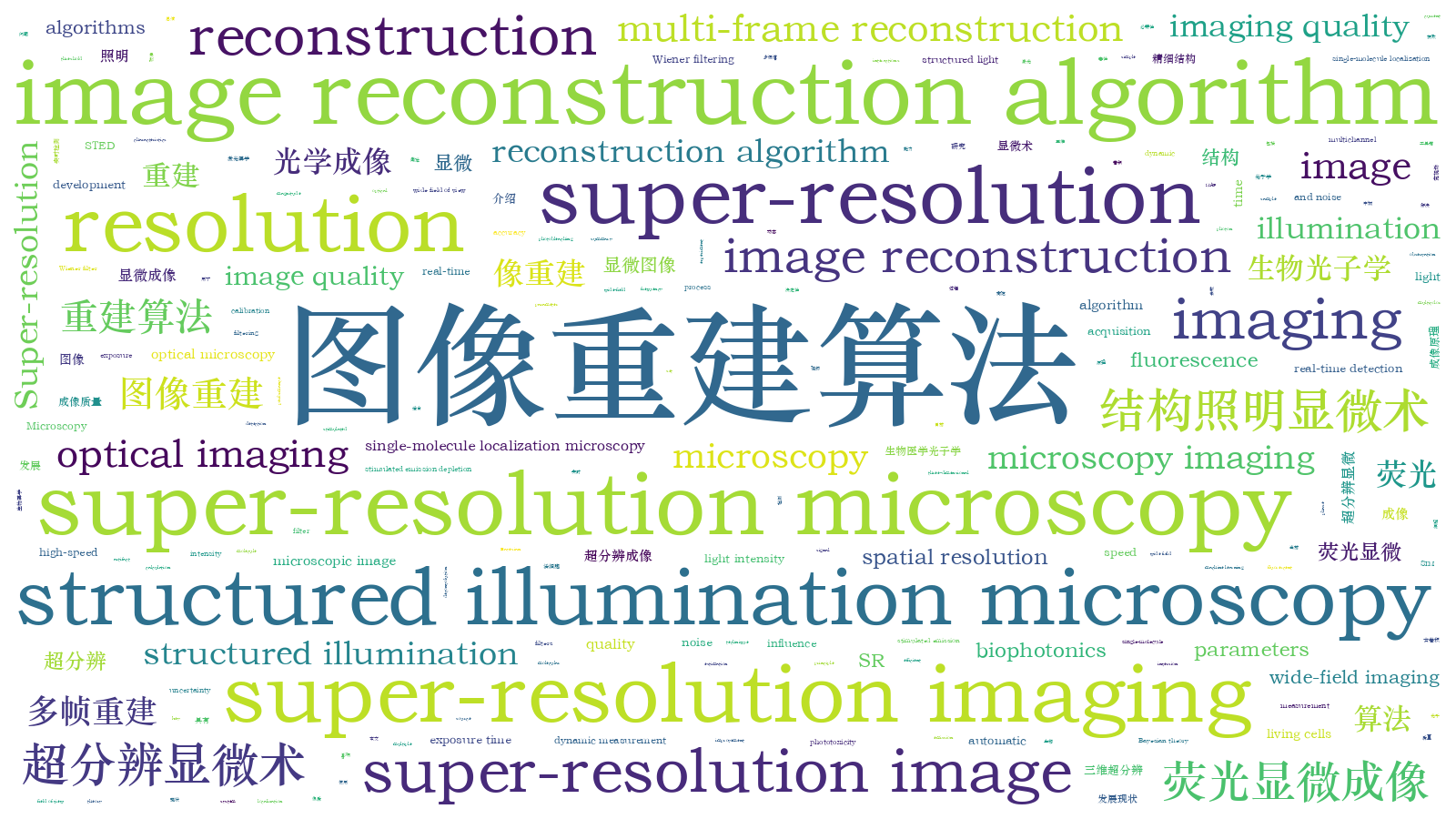基于结构照明的超分辨荧光显微成像重建算法  下载: 1719次
下载: 1719次
Significance Super-resolution microscopy overcomes the 200 nm spatial resolution limitation of traditional optical microscopy and has been widely used to image subcellular structures in living cells. Super-resolution microscopy mainly includes stimulated emission depletion (STED) microscopy, structured illumination microscopy (SIM), and single-molecule localization microscopy (SMLM). Super-resolution structured illumination microscopy (SR-SIM) is the most widely used super-resolution microscopy technique. Owing to the low phototoxicity, high-speed wide field of view, and multichannel three-dimensional super-resolution imaging capabilities, SR-SIM is especially suitable for real-time detection of dynamic fine structures in living cells. SR-SIM has high-speed wide-field imaging capabilities that enable rapid dynamic measurement of living cells. Compared with STED and SMLM microscopy imaging under a light intensity of ~1000 W/cm 2, SR-SIM allows imaging under a low light intensity of ~10 W/cm 2, which meets the requirement of long-term imaging of living cells. At the same time, multicolor and multichannel imaging by SR-SIM is beneficial to the study of molecular interactions.
The super-resolution structured illumination reconstruction algorithm (SIM-RA) is the key to realizing fast, long-term, and nondestructive super-resolution imaging of SR-SIM. SR-SIM uses structured light in different directions and phases to excite the fluorescent sample for acquiring multiple original images with illumination patterns and then reconstructs a single super-resolution image through mathematical calculations. Owing to the imperfection of the experiment and the inevitable uncertainty in the measurement of experimental parameters, the estimation of the reconstruction parameters results in false signal and noise, which reduces the resolution of the SR-SIM image and introduces artifacts that can be misinterpreted as biologically relevant features. An excellent SIM-RA can improve the accuracy of reconstruction parameters and filter out noise to reduce artifacts and ensure image quality. In addition, a long exposure time will increase the phototoxicity and photobleaching, which is not conducive to the long-time observation of living cells. SIM-RA can reduce the exposure time by two orders of magnitude for the reconstruction of SR-SIM images, allowing the use of fewer original images to achieve SR-SIM image reconstruction, providing longer and faster super-resolution imaging. Initially, SR-SIM requires users to have professional knowledge. The development of SIM-RA makes it unnecessary to manually set parameters, automatically obtain reconstruction parameters and estimate their uncertainty, and thus to reconstruct super-resolution images with a considerably reduced threshold. The super-resolution structured illumination microscopic image reconstruction process requires strict analysis and calculation to ensure the final super-resolution image quality and imaging speed, which relies on an efficient and stable SIM-RA.
In the past two decades, to achieve automatic, simple, and stable acquisition of high-quality and high-spatial-resolution reconstruction images, the development of super-resolution SIM image reconstruction algorithms has never stopped. Systematic summary and analysis of SIM-RA are necessary for users who want to construct a higher-performance super-resolution structured illumination microscopy system.
Progress This article systematically elaborates and analyzes the reconstruction algorithm of super-resolution structured illumination microscopy. First, it briefly introduces the realization principles and respective advantages of the three super-resolution microscopy techniques, i.e., STED, SIM, and SMLM, and expounds the necessity of studying SIM-RA based on the characteristics of SR-SIM imaging. Second, it introduces the imaging principle of SR-SIM based on structured illumination in detail, and focuses on SIM-RA. In view of the possible reasons for the poor imaging quality caused in the SR-SIM image reconstruction process and the improvement of the algorithm for fast, long-term, and nondestructive imaging of SR-SIM, the calibration and parameter value acquisition algorithms of SR-SIM, SIM-RA, and SR-SIM toolbox are analyzed and summarized. Initially, Gustafsson extended the Wiener filter and applied it to SR-SIM image reconstruction to solve the problem of reconstruction artifacts. Compared with Wiener filtering, the R-L deconvolution algorithm reduces the influence of photon noise on the imaging results, and MAP-SIM further reduces the influence of noise by suppressing defocused light (
Conclusion and Prospect The super-resolution SIM image reconstruction algorithm has a decisive influence on the imaging quality and imaging speed of super-resolution SIM. To achieve fast, stable, and automatic acquisition of high-quality, high-temporal-resolution super-resolution SIM images without artifacts, it is necessary to build better imaging algorithms. Excellent SIM-RA is necessary for reconstructing higher-resolution, faster, longer, and nondestructive SR-SIM images.
刘智, 罗泽伟, 王正印, 涂壮, 庄正飞, 陈同生. 基于结构照明的超分辨荧光显微成像重建算法[J]. 中国激光, 2021, 48(3): 0307001. Zhi Liu, Zewei Luo, Zhengyin Wang, Zhuang Tu, Zhengfei Zhuang, Tongsheng Chen. Super-Resolution Fluorescence Microscopy Image Reconstruction Algorithm Based on Structured Illumination[J]. Chinese Journal of Lasers, 2021, 48(3): 0307001.







